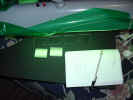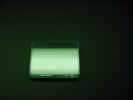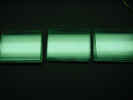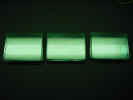






Making a Diagonal
There is a competitive market in diagonals for primary mirrors up to 12 inches so if you make one you will work at a loss. For mirrors larger than 20 inches you will be dealing with a specialty item and if you want a good one you will pay for it.
Diagonals from Scrap Glass
How to Make Diagonals
Diagonals from Scrap Glass
We have had the window company make us some 1 1/2 inch by 2 inch squares of 3/16 window glass for our demonstration and the window company has sanded the edges. The thickness is really too thin, it is hard to hold onto this thin glass without touching the first surface. At one time there was very flat plate glass on the surplus market. That type of glass would be just right for square diagonals.
The glass we have tried would work as telescope diagonal. By the time the light has traveled from the primary to the diagonal the image has partially formed so the diagonal is not quite so critical. On the other hand the coating charge will be 1/3 the price of a ready made diagonal and also if we test our mirror in the telescope this diagonal will be in the testing loop. If we want to tell errors in the diagonal from errors in the primary we will have to rotate the primary. Too frustrating, lets get a ready made diagonal.
How to Make Diagonals
I will tell you in advance that I am not an optician so what you read here is not from personal experience. Anyone who has made diagonals will tell you that it is easier to make a batch than to make just one. To make diagonals you will need a flat as a standard. To make a flat you will need to make three flats. If you test two candidate flats together and get straight fringes at any angle and offset they are both either flat or both spherical, one convex and the other concave. And so this is why we need the third candidate flat since the third flat cannot be both convex and concave spherical it will break a tie. If all combinations of three candidates tested together have straight fringes they are flat.
OK, lets presume we have a flat.
We mount the diagonals on a port hole glass with an adhesive that will flow slowly such as pitch and fill in around the edge with scrap glass. Next we grind the face of the diagonals against plate glass with 400 grit until the surface is all ground. If the plate glass is no longer flat get another piece. Grind with 12 and 6 micron abrasive. Next we lay a piece of waxed paper on our standard flat and press an un-grooved pitch lap onto the flat. Now we polish the diagonals on the pitch lap. If we press the pitch lap against the standard flat now and then our diagonals should become flat. Good luck, don't blame me if I got it wrong.